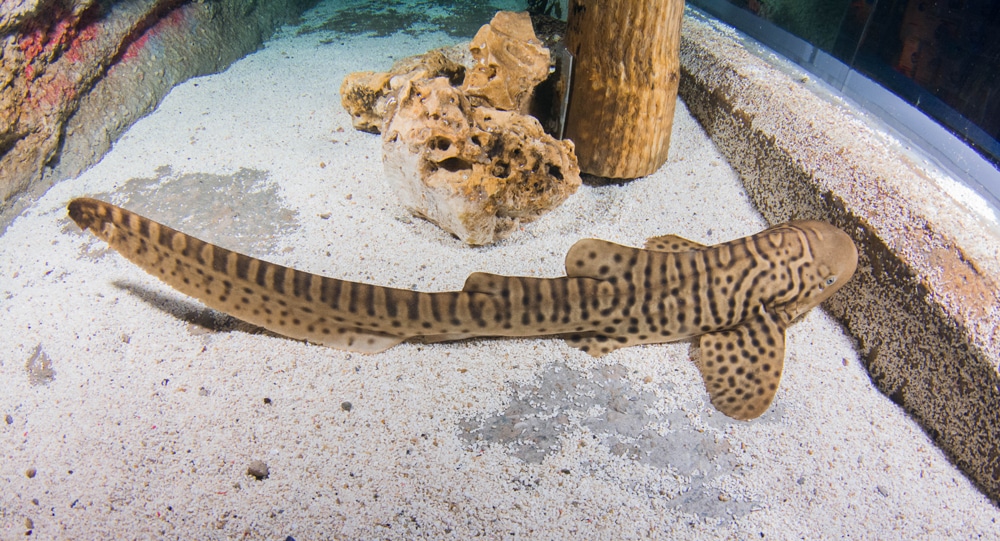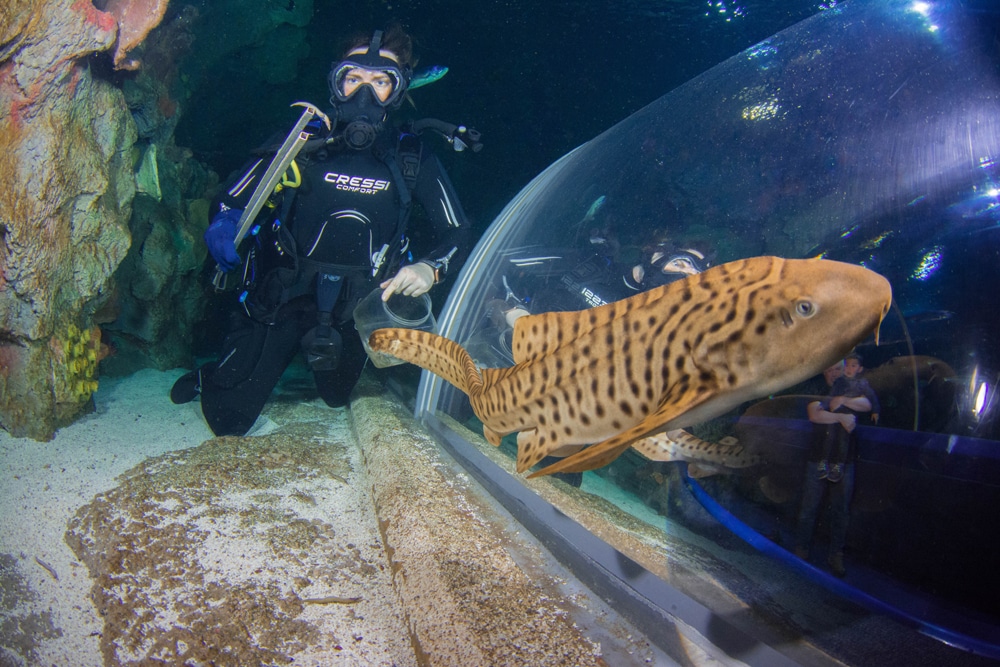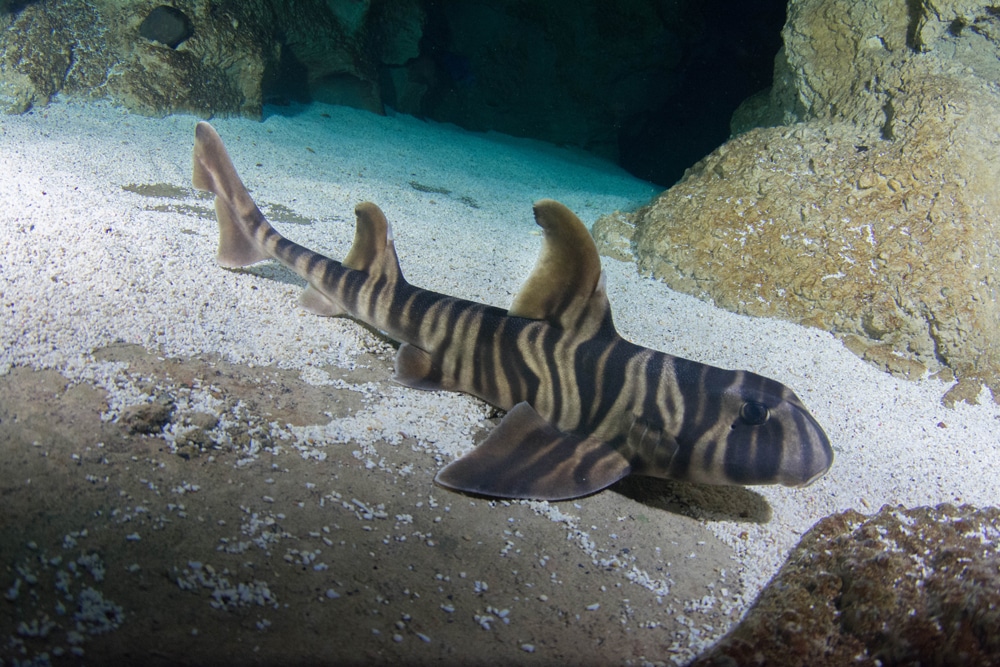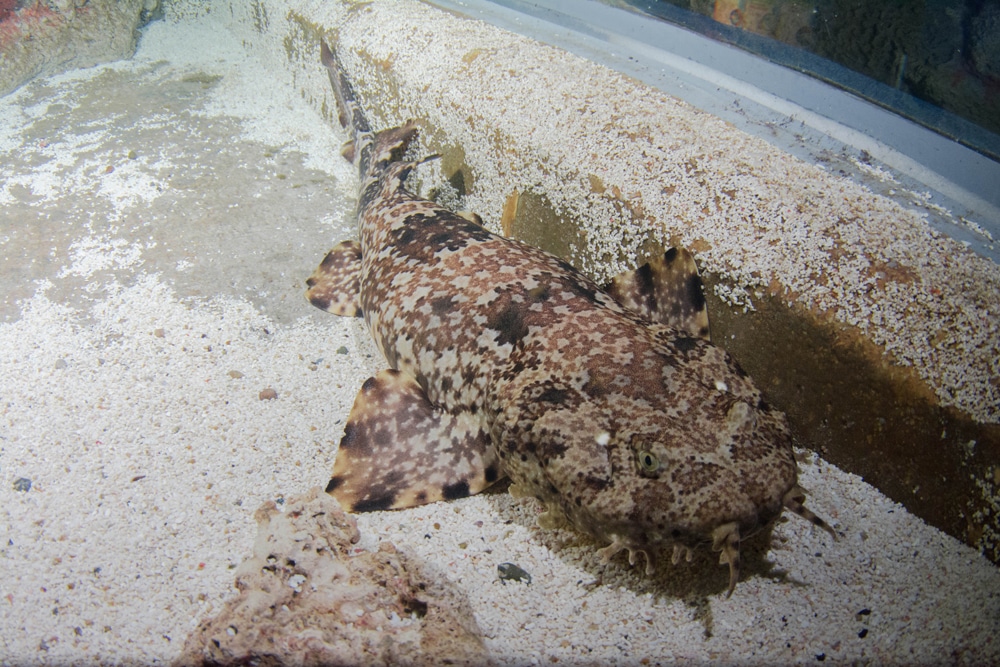Marine Life & Conservation Blogs
New Arrivals at Blue Planet Aquarium

 There’s been exciting times recently here at Blue Planet Aquarium, as we have had some new arrivals. When we get new arrivals its always an exciting time to be working in the Aquarium, however recently we’ve had some truly unique and unusual animals to join the rest of our collection of animals. So, this blog is going to be covering the newest members of the Blue Planet family, and why their uniqueness is so beneficial to our other animals.
There’s been exciting times recently here at Blue Planet Aquarium, as we have had some new arrivals. When we get new arrivals its always an exciting time to be working in the Aquarium, however recently we’ve had some truly unique and unusual animals to join the rest of our collection of animals. So, this blog is going to be covering the newest members of the Blue Planet family, and why their uniqueness is so beneficial to our other animals.
The new animals in question are Sharks with one being from a species we already have at the aquarium and two being completely new to the aquarium. Here at Blue Planet Aquarium we’re constantly trying to educate our visitors and show them new ways to appreciate our underwater world and the animals that we have living on this planet we call home.
So, lets dive straight in (no pun intended).
We’re going to start today with an animal that we already have two of and have had at the aquarium for several years, we have one teenage male named Marty (Named after the zebra from the Madagascar film) and Stripes (Named after Racing Stripes) however this new one is still a very young Shark and is a female who we’ve named Deborah the Zebra.
This species is also a hugely popular species here at Blue Planet and I would probably say are a favourite of mine, I am of course talking about our Zebra Shark. Zebra Sharks are identified by their yellowish- brown colouration with a spotty pattern covering their body, people usually ask at this stage why they’re called Zebra Sharks if they have spots. They’re called Zebra Sharks because when they’re young they’ve got Black & White Stripes all the way down their body, similar to that of a zebra, this species also has the second longest tail in the Shark world after the Thresher Shark.
The long tail combined with their striped pattern makes them look similar to that of the White-banded Sea Snake which has also lead some scientists to believe that this species may mimic the snake to deter predators, if this is the case then this would be the first case of protective mimicry in Sharks. Zebra Sharks are also one of the few Sharks that we know exhibit parthenogenesis which means that this species can lay viable eggs without a male needed, however all the pups born through this process will all be females. Zebra Sharks have also been found to share a very close relation to that of the world’s largest fish, the Whale Shark, we know this as their DNA is very similar and the Zebra Shark shares very similar features.
Our Zebra Sharks are all hand fed and eat a wide variety of foods such as Mackerel, Whiting, Saury, Squid and hard-shelled food such as Razor Clam. They’re incredibly friendly and regularly come in to investigate what’s going on, they’ll often rest against us and seem to show interest in having physical contact with members of the dive team, however we try and limit this as they wouldn’t get it in the wild, although sometimes we have to in order to stop them from trying to steal all the food or keep them at a distance that we can work with.
The next new Shark member is our Zebra Bullhead Shark, this is one of the more unusual Shark species that we have. It’s a member of the of the Horn Shark Family which is the same family of sharks as the Port Jackson Shark, this shark is very striking as it has very obvious Black and White Stripes and even more unusually, a small spike on both the Dorsal fin and Second Dorsal Fin which is where the name “Horn Shark” comes from. In this species early stages of life, they have a very similar striped pattern as their adult stage however their black stripes are more of a reddish-brown.
This species in the wild feeds mainly on hard-shelled foods such as crabs and molluscs however they wouldn’t say no to fish, ours is fed on fish, squid, razor clam and Mussel. Here at Blue Planet Aquarium we have just one Zebra Bullhead and ours is a male, this shark along with the next species I’ll be talking about are not yet named as we are having our guests choose names for us. Zebra Bullheads lay eggs rather than live birth, like mammals, and this group of sharks is a very ancient group with a long fossil record, that date these sharks all the way back to the early Jurassic which was around 201 million years ago.
The last two species are some of my personal favourites, which are known as Wobbegong Sharks. The name Wobbegong comes from the aborigine word for “Shaggy Beard”, this has led to them being lovingly known as “Wobbies” in Australia and among Shark enthusiasts. We have two species of Wobbegong here at Blue Planet Aquarium we have one Western Wobbegong and one Spotted Wobbegong, they both look vastly different in their patterns and markings and are one of the most unique and unusual Shark species.
Wobbegongs are Ambush predators that lie motionless on, or in, the seabed, rocky overhangs, crevices and caves. They wait to allow their camouflage to help them blend in with their surroundings, they do this until fish and other small animals come within striking range for the best chance of a successful hunt. To add success to a hunt it has been observed with the Tasselled Wobbegong, that they take part in active luring behaviour which is something seen in animals such as the Frogfish or Alligator Snapping Turtle. This is done with the Shark wedging itself into a cave or crevice with its head at the entrance and the tail curled over the top of its head, they then wave their tail side to side to mimic another fish, this is done to create the illusion that the cave is safe and free from predators and its then that the Shark strikes, grabbing any fish that comes too close.
Here at Blue Planet we feed ours on Squid, Mackerel, Saury, Sprat, Sand Eel and Prawn and we feed them via long pole. We do this as the strike from a Wobbegong is so quick that the human eye cant register it straight away, this also allows us to mimic hunting behaviour by giving the food a “swimming motion” to it which allows the animals to pick their target and hunt for their food rather than just feeding them.
These sharks are really important to us here at the aquarium as not only are they amazing and beautiful but they’re unusual looks and nature make them a reference point to just how diverse and incredible the Shark family is, sure everyone knows what a Hammerhead and Whale Shark is and as amazing as they are its always humbling to be able to show our guests just how unusual the Shark family can be along with the amazing traits and behaviours that comes along with them.
So, there you have it, some wonderful new arrivals here at Blue Planet Aquarium with each one being as amazing as the last. When you’re next at Blue Planet keep an eye out for these amazing new arrivals and make sure to appreciate just how strange and unique they are. Keep an eye out for future new arrivals and I’ll see you in the next blog.
For more information about Blue Planet Aquarium please visit their website by clicking here.
Marine Life & Conservation Blogs
Creature Feature: Dusky Shark

 In this series, the Shark Trust will be sharing amazing facts about different species of sharks and what you can do to help protect them.
In this series, the Shark Trust will be sharing amazing facts about different species of sharks and what you can do to help protect them.
This month we’re taking a look at the Dusky Shark, a highly migratory species with a particularly slow growth rate and late age at maturity.
Dusky sharks are one of the largest species within the Carcharhinus genus, generally measuring 3 metres total length but able to reach up to 4.2 metres. They are grey to grey-brown on their dorsal side and their fins usually have dusky margins, with the darkest tips on the caudal fin.
Dusky Sharks can often be confused with other species of the Carcharhinus genus, particularly the Galapagos Shark (Carcharhinus galapagensis). They have very similar external morphology, so it can be easier to ID to species level by taking location into account as the two species occupy very different ecological niches – Galapagos Sharks prefer offshore seamounts and islets, whilst duskies prefer continental margins.
Hybridisation:
A 2019 study found that Dusky Sharks are hybridising with Galapagos Sharks on the Eastern Tropical Pacific (Pazmiño et al., 2019). Hybridisation is when an animal breeds with an individual of another species to produce offspring (a hybrid). Hybrids are often infertile, but this study found that the hybrids were able to produce second generation hybrids!
Long distance swimmers:
Dusky sharks are highly mobile species, undertaking long migrations to stay in warm waters throughout the winter. In the Northern Hemisphere, they head towards the poles in the summer and return southwards towards the equator in winter. The longest distance recorded was 2000 nautical miles!
Very slow to mature and reproduce:
The Dusky Shark are both targeted and caught as bycatch globally. We already know that elasmobranchs are inherently slow reproducers which means that they are heavily impacted by overfishing; it takes them so long to recover that they cannot keep up with the rate at which they are being fished. Dusky Sharks are particularly slow to reproduce – females are only ready to start breeding at roughly 20 years old, their gestation periods can last up to 22 months, and they only give birth every two to three years. This makes duskies one of the most vulnerable of all shark species.
The Dusky Shark is now listed on Appendix II of the Convention on the Conservation of Migratory Species (CMS), but further action is required to protect this important species.
Scientific Name: Carcharhinus obscurus
Family: Carcharhinidae
Maximum Size: 420cm (Total Length)
Diet: Bony fishes, cephalopods, can also eat crustaceans, and small sharks, skates and rays
Distribution: Patchy distribution in tropical and warm temperate seas; Atlantic, Indo-Pacific and Mediterranean.
Habitat: Ranges from inshore waters out to the edge of the continental shelf.
Conservation status: Endangered.
For more great shark information and conservation visit the Shark Trust Website
Images: Andy Murch
Diana A. Pazmiño, Lynne van Herderden, Colin A. Simpfendorfer, Claudia Junge, Stephen C. Donnellan, E. Mauricio Hoyos-Padilla, Clinton A.J. Duffy, Charlie Huveneers, Bronwyn M. Gillanders, Paul A. Butcher, Gregory E. Maes. (2019). Introgressive hybridisation between two widespread sharks in the east Pacific region, Molecular Phylogenetics and Evolution 136(119-127), https://doi.org/10.1016/j.ympev.2019.04.013.
Marine Life & Conservation Blogs
Creature Feature: Undulate Ray

 In this series, the Shark Trust will be sharing amazing facts about different species of sharks and what you can do to help protect them.
In this series, the Shark Trust will be sharing amazing facts about different species of sharks and what you can do to help protect them.
This month we’re looking at the Undulate Ray. Easily identified by its beautiful, ornate pattern, the Undulate Ray gets its name from the undulating patterns of lines and spots on its dorsal side.
This skate is usually found on sandy or muddy sea floors, down to about 200 m deep, although it is more commonly found shallower. They can grow up to 90 cm total length. Depending on the size of the individual, their diet can range from shrimps to crabs.
Although sometimes called the Undulate Ray, this is actually a species of skate, meaning that, as all true skates do, they lay eggs. The eggs are contained in keratin eggcases – the same material that our hair and nails are made up of! These eggcases are also commonly called mermaid’s purses and can be found washed up on beaches all around the UK. If you find one, be sure to take a picture and upload your find to the Great Eggcase Hunt – the Shark Trust’s flagship citizen science project.
It is worth noting that on the south coasts, these eggcases can be confused with those of the Spotted Ray, especially as they look very similar and the ranges overlap, so we sometimes informally refer to them as ‘Spundulates’.
Scientific Name: Raja undulata
Family: Rajidae
Maximum Size: 90cm (total length)
Diet: shrimps and crabs
Distribution: found around the eastern Atlantic and in the Mediterranean Sea.
Habitat: shelf waters down to 200m deep.
Conservation Status : As a commercially exploited species, the Undulate Ray is a recovering species in some areas. The good thing is that they have some of the most comprehensive management measures of almost any elasmobranch species, with both minimum and maximum landing sizes as well as a closed season. Additionally, targeting is entirely prohibited in some areas. They are also often caught as bycatch in various fisheries – in some areas they can be landed whilst in others they must be discarded.
IUCN Red List Status: Endangered
For more great shark information and conservation visit the Shark Trust Website
Image Credits: Banner – Sheila Openshaw; Illustration – Marc Dando
-

 News3 months ago
News3 months agoHone your underwater photography skills with Alphamarine Photography at Red Sea Diving Safari in March
-

 News3 months ago
News3 months agoCapturing Critters in Lembeh Underwater Photography Workshop 2024: Event Roundup
-

 Marine Life & Conservation Blogs2 months ago
Marine Life & Conservation Blogs2 months agoCreature Feature: Swell Sharks
-

 Blogs2 months ago
Blogs2 months agoMurex Resorts: Passport to Paradise!
-

 Blogs2 months ago
Blogs2 months agoDiver Discovering Whale Skeletons Beneath Ice Judged World’s Best Underwater Photograph
-

 Gear Reviews3 months ago
Gear Reviews3 months agoGear Review: Oceanic+ Dive Housing for iPhone
-

 Marine Life & Conservation2 months ago
Marine Life & Conservation2 months agoSave the Manatee Club launches brand new webcams at Silver Springs State Park, Florida
-

 News3 months ago
News3 months agoWorld’s Best Underwater Photographers Unveil Breathtaking Images at World Shootout 2023

























